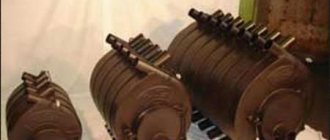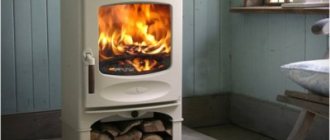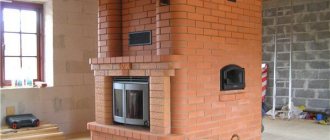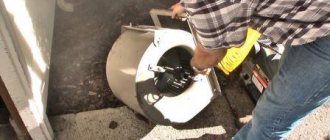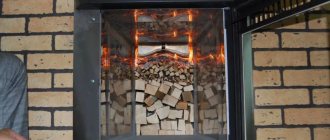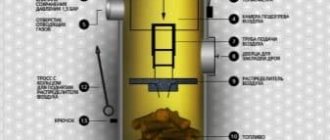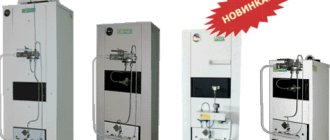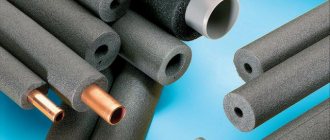Operating rules
Despite the simplicity of execution, you need to heat the Buleryan stove using certain knowledge and rules:
- For ignition, it is necessary to use exclusively dry and solid fuel, wood chips, pressed cardboard, and small boards.
- Do not clean out the coal and ash formed after ignition; their layer will protect the metal bottom from burning out;
- The main fuel loading occurs after most of the ignition has burned out, namely 2/3 of the total initially loaded fuel;
- You should not use wet firewood and coniferous wood - they will cause plaque to form on the walls of the stove and chimney, reducing the efficiency of the heating system;
- Experts do not recommend using coke and coal, as they burn too quickly and do not allow the air to warm up enough;
- Maximum efficiency is achieved through a closed damper and blower: convection processes in this case begin to work more efficiently;
If all these operating rules are taken into account, the outer casing will not heat up to high temperatures, and the air leaving the pipes will reach its maximum temperature in less time. The heating system of the building using a long-term fuel combustion furnace, called Buleryan, involves saving fuel while providing high-quality heating of the air inside the building
Such stoves are very effective in country houses, garages, greenhouses and agricultural buildings. They are quite safe to use. But the main advantage of these heating systems can be considered that the manufacture of a Buleryan stove is possible at home, without the use of complex technologies and expensive materials
The heating system of the building using a long-term combustion furnace, called Buleryan, involves saving fuel while providing high-quality heating of the air inside the building. Such stoves are very effective in country houses, garages, greenhouses and agricultural buildings. They are quite safe to use. But the main advantage of these heating systems can be considered that the manufacture of a Buleryan stove is possible at home, without the use of complex technologies and expensive materials.
Heating stove Breneran Aquaten: reviews of owners and types of models
Breneran-Aquaten stoves are distinguished by their diversity and each consumer can choose exactly what he needs.
The most common models are:
- AOTV-6 is a lightweight and compact stove that can heat a room up to 100 cubic meters. cm. One tab can burn for 8 hours. Made in black and should only be placed near the wall. The cheapest model, as it does not have any additional functions.
- AOTV-11 - can heat a room of 200 cubic meters. cm. Burns for 10 hours on one burnt. A little more expensive than the previous one.
- AOTV-14 is a more powerful model. Heats an area of 400 cubic meters. cm. One firebox is enough for 10 hours.
- AOTV-16 is a large and heavy stove. But at the same time, it can burn for almost 12 hours and is capable of heating a room of up to 600 cubic meters. cm.
- AOTV-19 is the most powerful and efficient stove. It can also burn for 12 hours and efficiently heat a room of up to 1000 cubic meters. see The most expensive boiler in this series.
When choosing a stove, you should pay attention to its characteristics: to heat a small house, you do not need to buy an expensive and powerful boiler.
Opinions of Breneran-Aquaten stove owners:
- Kirill. I bought a Breneran stove for my dacha. It suited me perfectly in terms of price and power. There were no problems with the installation. I just had to tinker a little with the chimney pipe. After I turned on the stove for the first time, a specific smell appeared, but then it disappeared and I didn’t feel anything like that anymore. It takes less than an hour to ignite and heats well. I'm happy.
- Katerina. My husband and I bought a Breneran-Aquaten stove for our wooden house. It was easily connected to the pipes and began to be used. I liked that the boiler turned out to be “omnivorous”. We even used the remains of old furniture. The main thing is that the material is dry. I didn't like the appearance of condensation. It’s bad that there is no special container to collect this liquid.
- Andrey. Breneran purchased a stove for his workshop and lined it with sheets of iron just in case to prevent a fire. I'm happy with everything, although at first there was a lot of soot in the chimney. I had to clean it very often. When I started using dry firewood, the problem practically disappeared.
Device
These types of fireplace stoves consist of a massive outer casing, the thickness of which is 3 mm, as well as a heat-resistant firebox made of 5 mm steel. In addition, the package includes an additional water tank made of stainless steel.
The operation of such a device follows the same principle as that of a gas generator. After solid fuel burns, the resulting gases enter special ejectors for more complete combustion.
It is due to this that it is possible to achieve such high efficiency indicators, about 80%. In addition, such furnaces can operate in several modes. The first is fast heating, and the second is gasification. Accordingly, each of them performs its function, one allows you to quickly increase the temperature, and the second maintains it at the desired level.
It all happens as follows: special air ducts are put on pipes with a large diameter, which supply heated air to the required rooms. In addition, even cheap aluminum options that can withstand average temperatures can be used as these pipes. Due to this, even the smallest oven allows about 5 cubic meters of air to pass through it.
Operating principle of the Breneran Aquaten stove
Buleryan (Breneran) heating boilers with a water circuit, in their design, are not much different from traditional equipment that uses the principle of air convection. The design includes pipes surrounding the combustion chamber. The principle of gas generation or pyrolysis is used. The main difference is that instead of air, liquid coolant circulates through the pipes.
Breneran long-burning boilers with a water circuit operate as follows:
- A special collector is mounted on the convection pipes at the top and bottom.
- On the lower manifold there is a return outlet, on the upper one for supplying coolant.
- During combustion, the coolant heats up, which creates pressure in the heating system, allowing for natural circulation, as well as the rise of the liquid to a height of 8 m. The coolant is supplied through pipes to heating devices located in the rooms.
- After cooling, the coolant returns through the return line back to the boiler to the pipes connected to the lower pressure manifold.
At the same time, Buleryan water boilers use the principle of gas generation or pyrolysis, which allows the use of gas produced during the combustion of solid fuels. The design has two combustion chambers. In one, wood is burned, in the second, gases are burned.
After heating the combustion chamber to the required temperature, the boiler is switched to gas generation mode. During gas generation, the fuel does not burn, but literally smolders, which increases autonomous operation from one load, while maintaining the heat transfer coefficient at the level of conventional wood burning.
Canadian long-burning "potbelly stoves" Breneran, were developed to operate on wood. The use of peat and wood briquettes, as well as wood waste, is allowed, but at the same time the energy efficiency and heat transfer indicators decrease slightly.
The best electric kebabs in the mid-price range
The price for such electrical appliances usually starts from 2000 rubles. This is somewhere between inexpensive and premium options. They hold approximately 1.5 kg of meat and can cook not only it, but also fish, mushrooms, and grilled vegetables. These kebab makers are inferior to more expensive offerings mainly only in functionality. The products described in this category are recognized as the best in terms of build quality, ease of use and reliability of use.
Kitfort KT-1403
...We tested Kitfort KT-1403 and were convinced that it helps to cook shish kebab no worse than over charcoal. This effect is ensured by an infrared heater, which is responsible for uniform cooking of meat... Expert opinion
This electric kebab maker has a somewhat unusual appearance compared to other products in the rating. It comes in a rectangular shape, but is very convenient to use. There is enough space inside the case; 5 skewers, completely covered with meat, can easily fit here. During cooking, you can simply turn them for better roasting of pork, chicken and other products, since there are plastic holders on top that do not heat up. Very usefully, there is also a handle on the side for carrying the product. Even at high speed, the structure is stable on the surface due to reliable support.
Advantages
- Easy to disassemble for cleaning;
- Easy to wash;
- Does not heat up;
- Automatic rotation of skewers;
- You can cook up to 1.5 kg of kebabs at a time.
Flaws
Short power cord.
Energy Neva-1
This is an almost fully automated electrical appliance for preparing barbecue at home. Uniform frying of the meat is guaranteed here thanks to the automatic rotation of the skewers, on which, by the way, you can thread more than 1.5 kg of meat. There are 5 pieces in total in the set. with the optimal size, so this product will be useful even in a large family. It is easy to care for due to its removable parts. There are almost no drawbacks here, even the considerable energy consumption does not bother users, for which the electric kebab maker can safely be given second place in the rating.
Advantages
- Reliable protection of the heating element;
- Free rotation of skewers;
- Large flask;
- Does not give off a strong odor, you can safely fry right in the apartment;
- The design is washed easily and quickly.
Flaws
Fat sometimes comes out of the flask, and it must be washed off immediately after cooking.
The Energy Neva-1 electric kebab maker has a power of 1000 W, and therefore it is not surprising that the meat is fried in it in 15-20 minutes.
Hydroelectric unit Kavkaz-2
This device is ideal for those who do not chase the pronounced smoky smell of barbecue. If it is very important, then, as a last resort, you can put 1-2 cherry branches in the flask, which enhance the aroma. The kebab maker has a red body, which can be easily removed if necessary. The design is stable on the surface thanks to durable legs. It is quite easy to wash, although it does not get so dirty due to the presence of a tray for collecting grease. As in all modern models, the skewers here rotate independently, which simplifies its use.
Advantages
- No need to baste the meat;
- There is no need to twist the skewers by hand;
- Good power of 1000 W;
- Cooking speed – 20 minutes;
- Easy to disassemble;
- You can load 1 kg of meat, fish, mushrooms at a time.
Flaws
- After cooking, you need to ventilate the room.
- Sharp edges on skewers.
Manufacturing options
Today, two options for manufacturing the Buleryan stove are known, based on the materials they are made from: from profile and curved pipes or from a gas cylinder. Each type of system has its own efficiency and varies in implementation complexity:
- From a profile pipe. The Buleryan system made from a profile pipe is a simple design that provides efficient heating of small spaces: a garage, greenhouse, barn or small gym. The stove is easy to manufacture and can be made by any welder from scrap materials.
- From a gas cylinder. Due to the fact that almost every private yard has an old gas cylinder, this type of stove is made quite often. An excellent solution for a country house or garage, and thanks to the shape of the cylinder, it becomes possible to implement interesting design ideas.
The Buleryan stove is easy to make with your own hands, no matter what type you decide to make yourself. The choice depends on the capabilities of the master, the availability of material and the skills of the owner
Wood stove design
Despite the fairly wide variety of models (cast iron, brick), almost all wood-burning stoves have the same design elements:
- Foundation or foundation. A necessary element when installing any stove. Its main purpose is to prevent deformation of the soil or floor surface under the stove.
- Frame. Can be lined with brick or made of cast iron.
- Combustion chamber. The space in which combustible material is converted into heat.
- Ash pit. From the name it becomes clear that the resulting ash and ash fall into the ash pan.
- Kamenka. More complex designs of sauna stoves include a heater - a space inside the stove filled with stones to produce dry steam. .
- Chimney. System for removing smoke from the room. Chimney design is a very important part of installing a wood stove. An incorrectly installed chimney can lead to disastrous consequences when heating a room with a stove. We will talk in detail about the design of a wood stove chimney, its installation and operating rules in this article.
More detailed information about the design and types of wood-burning stoves can be found on our website. Anyone interested in purchasing their own heating boiler should read it.
Manufacturing options
Today, two options for manufacturing the Buleryan stove are known, based on the materials they are made from: from profile and curved pipes or from a gas cylinder. Each type of system has its own efficiency and varies in implementation complexity:
- From a profile pipe. The Buleryan system made from a profile pipe is a simple design that provides efficient heating of small spaces: a garage, greenhouse, barn or small gym. The stove is easy to manufacture and can be made by any welder from scrap materials.
- From a gas cylinder. Due to the fact that almost every private yard has an old gas cylinder, this type of stove is made quite often. An excellent solution for a country house or garage, and thanks to the shape of the cylinder, it becomes possible to implement interesting design ideas.
The Buleryan stove is easy to make with your own hands, no matter what type you decide to make yourself. The choice depends on the capabilities of the master, the availability of material and the skills of the owner
DIY Buleryan stove design
- First, firewood is placed in the firebox, ignited and the active combustion mode is set;
- after this the oven is put into smoldering mode;
- With the help of special blowers, hot air begins to spread throughout the room.
The first mode heats the firebox very quickly, providing an outlet temperature of more than 100 degrees. This takes about 30 minutes. After this, the firebox is completely filled with dry logs and the air supply is reduced using a special regulator located outside the housing. The oven goes into smoldering mode. Thanks to this, the temperature of 50 degrees lasts 10 hours. Therefore, if the Buleryan stove is filled with wood twice a day, then round-the-clock heating is provided.
Heating stove Breneran - features and reviews
For residents of private houses, there is an alternative to traditional types of heating - solid fuel stove equipment, used in places inaccessible for gas connections or as an addition to other types of devices to save energy. The recognized leader among the products of this class presented on the national market are the Breneran brand stoves, produced under a Canadian license in Russia, which evoke extremely positive reviews from their owners.
Advantages and disadvantages
Easy-to-use Breneran equipment is used for heating houses and baths, industrial premises and hangars. The reason for this popularity was its inherent qualities:
- high efficiency and cost-effectiveness;
- autonomy of Breneran operation, regardless of the presence of gas or oil products;
- as reviews show, the stoves function equally well on any type of solid fuel;
- uniform heat distribution throughout the entire volume of the room;
- compactness and ease of maintenance of the furnace;
- Efficiency can reach 80%, power regulation is provided.
Numerous reviews confirm the consistency of the characteristics when used in buildings for various purposes and stable operation on one tab for 12 hours. Their disadvantages are associated with design features. An open combustion chamber takes air from the room for the combustion process, which leads to its drying and the spread of a specific odor. At the same time, drops of condensate settle on Breneran’s pipes, as the slow smoldering of the fuel causes the exhaust gas to cool in the chimney. But at the same time, consumers who left reviews about the operation of stoves consider these points to be unimportant, and to solve the problem of heat loss when transferring it through pipes to neighboring rooms, they advise installing a casing.
Externally, the stove resembles a drum made of durable steel with thick walls, a heat-resistant coating and a set of pipes for quickly heating the air and distributing it evenly throughout the house due to natural convection. The device consists of two combustion chambers, from which fuel is burned in the lower one, and the resulting gas is burned in the upper one. There are power regulators on the door and in the chimney. Since Breneran is a long-burning stove, the wood in it does not burn, but smolders slowly, which is achieved by setting the gasification mode after preliminary combustion of the fuel.
The room is heated not only by the release of heat from the metal surface of Breneran, but also by the movement of air heated in the pipes, which, according to reviews, significantly increases the efficiency of the stove. If it is necessary to heat other rooms, a system of heat-distributing air ducts is installed.
Customers' opinions
“I don’t go to the dacha very often, and therefore I didn’t pay for connecting to the gas pipeline, I decided to buy a Breneran wood stove, which I don’t regret. Inexpensive and powerful enough for a small area (I have about 60 m2). They delivered it and installed it quickly, although we had to tinker a little with the chimney. After turning on the stove for the first time, as was written in the reviews, an unpleasant smell appeared in the room, but later there were no such problems. Now, when I arrive in a cold house before the weekend, I fire it up and it takes less than an hour to warm up. Then I switch it to gasification mode and add firewood twice a day.”
Pipe measurements using improvised means
Most often, the well-known caliper is used to measure the diameter of a pipe. But you may not have it, or if you do have it, it may not be possible to measure a large pipe diameter with it. In this case, the simplest set of tools and knowledge is used:
- flexible ruler (similar to the type of measuring tape used in sewing);
- roulette;
- school knowledge of the number Pi (it is equal to 3.14).
Using a similar set of tools, you can measure the diameter of not only a pipe, but also any other round object - a rod, column or garden bed.
We only need to make one measurement - determine the circumference of the pipe using a tape measure or flexible ruler. To do this, a measuring tape or tape measure is placed on the surface of the pipe in its widest part. The resulting circumference value should be divided by 3.14. For more accurate dimensions, use the value 3.1416.
It should be noted that imported supplies of pipes are accompanied by documentation that already indicates the pipe diameters in inches. To convert these values to centimeters, they are multiplied by 2.54. Similarly, to convert centimeters back to inches, multiply by 0.398.
How to properly install a chimney system?
Even the most expensive and correct chimney for Buleryan will not cope with the assigned tasks if the rules were violated during installation of the structure. The following lists the main installation features.
External installation of a chimney
Installation work is carried out according to the following plan:
- A hole is created (in the roof with a vertical outlet or in the wall when the pipe is led out along the facade of the house).
- The chimney elements are assembled and fastened together.
- The distance between the walls of the hole and the chimney device is filled with non-flammable insulation.
- After pulling it out, the structure is attached to the wall or roof with clamps.
- When the chimney system rises above the roof by more than 2 meters, a stretcher is installed to protect from the wind.
If you decide to route the pipe through a window, then cutting out holes is not necessary. This is convenient, but the appearance will not be neat
Options for exhausting the chimney outside
In-house chimney installation
When arranging a roof cut, it is important to take into account that the pipe can heat up to 50-60 degrees, and the steam at the exit can have a temperature above 300 degrees. This means that all nearby wall and roof materials must be heat-resistant, and there should be no gas pipes or fuel storage nearby.
Between the chimney device and the roofing materials you will have to make a penetration with a fire gap of 25-30 centimeters.
Don't make mistakes, there are consequences
Connecting a chimney for Buleryan
To complete this installation step, you will need an adapter. The role of the adapter is performed by a standard stainless steel pipe. After all installation work, a traction check is required. This is done using open fire. In the oven, open the damper and bring in a lit match or piece of paper. The flame should be drawn steadily into the firebox, the smoke should not go into the room, but should be directed strictly through the chimney.
Adapter for connecting the chimney to Buleryan
Installation option 1
Installation option 2
Breneran stoves
Breneran stoves (previously produced under the Buleryan brand) are widely used for heating residential premises, workshops, warehouses, garages, etc. Simple installation, high efficiency and attractive price made them very popular in Russia.
Features of installing chimneys for Breneran stoves
The original design provides Breneran furnaces with very high efficiency. This automatically means that the furnace flue gases will have a very low temperature. In practice, the outlet gas temperature is only 200-250 degrees Celsius.
When passing through the chimney, the flue gases are cooled. If the chimney is well insulated and the flow rate of the flue gases is high enough, combustion products will successfully pass through the chimney without forming condensation. In practice, condensation still forms, and if the chimney is installed incorrectly, it forms in large quantities.
Ways to reduce condensate volumes:
- optimal diameter. The instructions for the Breneran and Buleryan stoves indicate the optimal dimensions of the chimney. The use of pipes with a larger or smaller cross-section impairs traction;
- optimal chimney height. In general, the pipe should be at least 5 meters. Specific parameters for specific oven models are indicated in the instructions;
- round section of the chimney. The round cross-section is optimal in terms of draft and, as a consequence, the speed of smoke passage;
- simple configuration. The ideal option is a straight vertical chimney. If the chimney must include horizontal elements, their length should be minimal;
- smooth inner surface. That is why it is not recommended to use brick chimneys without liners for Breneran stoves. A large amount of condensate settles on the uneven surface of the bricks, which quickly destroys the chimney;
- thermal insulation. The ideal option for installing a chimney for Breneran stoves is three-component ceramic or double-circuit steel systems. Effective thermal insulation will allow you to maintain a high temperature in the chimney - this improves draft.
External and internal chimney
The chimney for the Breneran stove can be located both inside the building and outside. An external chimney is easier to install (only one passage through the wall is required), but it is often difficult to “fit” into the design of the facade. In addition, the horizontal chimney element significantly worsens draft.
The internal chimney can be completely vertical, but its installation requires passage through the floors and roof. In addition, such a chimney takes up space in the premises, and running it through living rooms is prohibited in principle.
How to order?
For additional information and to order a surveyor to estimate the cost of installing a chimney, you can call 8 (495) 972 – 58 – 42.
What elements should a chimney consist of?
Required elements:
1. Main pipe. Displayed vertically. Pipes can be single-walled (not insulated) and insulated (sandwich). Go to the chimney pipe section2. Tee. Serves for joining the horizontal and vertical sections of the chimney. The use of elbows (corners) for these purposes is not recommended, because During operation of the stove, condensation forms on the walls of the chimney. If you use an elbow, then all the condensate will drain into the oven. To prevent this from happening, use a tee. In addition, the tee will be useful if you need to clean the chimney. Go to the chimney tees section
3. Watering can Installed as a plug on the underside of the tee (now shown upside down for clarity). You can put a hose on the pipe and drain the condensate, for example, into a bucket or sewer. Go to the chimney watering cans section
4. Fungus Protects against precipitation getting into the pipe. Go to the chimney fungi section
5. Fastening Attaches the chimney to the wall. Because pipes have a maximum length of 1 m, therefore, they need to be fastened at least every meter. Go to the chimney fastening section
Additional items
1. Horizontal pipe Connects the furnace pipe and the tee. It is used if the vertical pipe is located at a distance from the stove itself (for example, if the chimney is routed through an external wall). 2. Kryza Serves as the basis for a sealed passage of the chimney through the roof. Layed in a herringbone pattern - the bottom part is laid on the roof covering; the top one is slipped under the covering. A pipe is inserted inside. The distance between the pipe and the roof is covered with comfrey. Go to the chimney roof section 3. Okapnik Covers the distance between the chimney and the roof. Structurally, it is a clamp with a “skirt”. Go to section 4. Deck Covers the lower part of the tee with a watering can. Can only be used with insulated pipes (the photo shows it “upside down” for clarity). Go to the decks section
Advantages
The classic version of the Breneran stove is an all-metal structure that includes a large number of pipes that create forced convection.
Therefore, the heated air quickly heats up and spreads throughout the room.
And due to its clever design, the stove manages to take air from under the floor, warm it up in a matter of seconds, and then direct it upward, creating circulation. On average, the outlet temperature is up to 150 ˚С
It is worth noting that the burning time of one bookmark in such a stove will depend on many factors. So, it could be:
- firewood quality;
- total height of the chimney;
- in what mode the stove is operated;
- various nuances of the Breneran installation.
So, for example, some bathhouse attendants manage to provide heating for up to 12 hours in a row in one load. Although at the same time, it will not be possible to provide high-quality heating. It is most correct that with one load the furnace operation lasts an average of 7 hours. This will allow you to achieve maximum effect.
The main advantages of such furnaces are:
- high productivity (about 80%);
- greater efficiency;
- possibility of heating in a short period of time;
- versatility, allowing use both in the house and in the bathhouse;
- independence from stationary fuel sources (gas, electricity).
Considering the simplicity of the entire design of such a stove, in most cases it surpasses its main competitors in the form of gas boilers for private homes in many respects.
The most important thing is that it does not release any harmful substances into the air. In addition, an important point is that the design of such furnaces has been tested by time.
High-quality Breneran Aquaten stove and its structure
In order to be able to heat not only the space around the stoves, but also the entire room, a water circuit is built into the heating equipment with an operating principle similar to central heating. It looks like an ordinary coil with liquid heated inside. It then spreads through pipes throughout the house and heats it up.
You can familiarize yourself with the design of the Breneran Aquaten stove yourself using the Internet
The body of this furnace is made of steel and treated with heat-resistant enamel, and of :
- Two chambers – the lower one for fuel and the upper one – for afterburning the gas released during combustion;
- Two injection manifolds located on the sides - it is through them that water enters, is heated and exits;
- Two power regulators installed in the chimney and on the door.
Depending on the equipment models, stoves may have different chimneys, volumes, and parameters.
If the stove is used for a closed heating system, then for its operation a circulation pump, safety valve, air vent, pressure gauge and expansion tank are also purchased.
By the way, Breneran-Aquaten stoves operate only on solid fuel. But it does not use coke or coal.
For high-quality and efficient operation of such a stove, you need to completely fill it with fuel, and then one fill will be enough for 8-10 hours.
Basic requirements for chimney ducts
As a rule, a diagram for arranging a smoke exhaust shaft is attached to the operating instructions for the solid fuel boiler itself, since each heating system has its own technical features. But for all models of such boilers, the pipe installation scheme must meet modern fire safety requirements - especially if there are tall trees near the section of the roof through which the chimney passes.
The following requirements apply to chimney ducts:
The height of the pipe is indicated, as a rule, in technical specifications. passport for the boiler
It is extremely important that you adhere to the indicated figures when arranging the chimney shaft. In addition, when calculating the height of the duct, you should take into account the height of the roof itself, its angle of inclination, the distance to the ridge, etc. The chimney must be positioned strictly vertically - only if this condition is met fuel combustion products will be quickly and completely removed outside the premises. It is important that the cross-sectional area of the channel is greater than the cross-sectional area of the outlet pipe in the heating boiler. In extreme cases, these parameters can be the same
But it is unacceptable for the cross-sectional area of the pipe to be smaller than that in the outlet pipe. Arrangement of the acceleration area. This part of the chimney is necessary for horizontal and vertical connection of the chimney to the heating boiler. First, a short pipe or tee is installed, and after it a 1 meter of vertical pipe is installed. Its task is to “launch” the draft of smoke. After it, you can install horizontal sections and branches of the shaft.
If the roof of your house is made of flammable materials, consider installing a deflector: it will ensure that sparks are extinguished in the event of incomplete combustion of wood.
Experts recommend choosing a place to mount the umbrella with special attention. It is installed in the area of wind pressure
You can find this zone as follows: select the point that is closest to the top of the chimney pipe (this could be the ridge of the roof), and mentally draw a segment connecting the selected point with the horizon line at an angle of 45°. The umbrella should be placed above the resulting segment.
Review of the Breneran long-burning stove with a water circuit: instructions for use
Long-burning gas generator stoves have gained great popularity in countries with harsh climates, where temperatures below zero degrees remain for several months. Inexpensive, reliable and economical. And if such a stove also has a built-in water circuit, then it becomes indispensable in many ways. After all, it can be used both for heating air in a residential or industrial premises, and for heating a house, cottage or garage.
Let's look at the main types of long-burning stoves with a water circuit presented on the Russian market, using the example of the Breneran-Aquaten or "Aqua-Breneran" stoves, which have different reviews from owners and stove makers. We will also consider their technical characteristics, operating principle, model range and prices.
This is probably the most famous and popular oven of this type. Its prototype was taken as a basis - this is the Breneran stove
(Buleryan). Then the engineers modified it somewhat and, by installing a heat exchanger in it, made it possible to use it not only to heat the surrounding air, but also to heat the coolant in the heating system.
Construction of the Breneran-Aquaten stove (Fig. 1)
Construction of the Breneran-Aquaten stove
The stove body is welded from steel and covered with heat-resistant black enamel. There are two combustion chambers inside this furnace: upper and lower. In the lower chamber, the process of producing gases from solid fuel occurs, and in the upper chamber, the afterburning of these gases occurs, followed by heat generation.
There are 2 manifolds with built-in injectors on the sides. To adjust the power and operating mode, two dampers are installed on the stove: on the front of the door (4 - Fig. 1) and on the rear chimney pipe (3.5 - Fig. 1). For supplying and discharging coolant, there are two threaded manifolds on the unit body (1,2 - Fig. 1). The diameter of the chimney can be different, depending on the type of Aqua-Breneran: from 120 to 180 mm.
AOTV Breneran-Aquaten stoves come in several types:
— AOTV-6 type 00 — AOTV-11 type 01 — AOTV-14 type 02 — AOTV-16 type 03 — AOTV-19 type 04
They differ from each other in size, power, combustion chamber volume, and weight. Selected according to the area of the heated room. The smallest will heat up to 100 m3, the largest up to 1000 m3.
Technical characteristics of a long-burning furnace with a water circuit Breneran-Aquaten
Technical characteristics of Breneran-Aquaten
Which fuel is best to use
Almost any solid fuel is relevant for the Breneran-Aquaten stove: firewood, peat, cardboard, wood chips and sawdust, except coal and coke. It must be remembered that for the correct operation of such a stove, you need to ensure that when lighting the lower chamber is completely filled with fuel. In this case, the manufacturer guarantees operation on one load of solid fuel for up to 8-10 hours.
Using the water circuit of the Breneran furnace
Such a long-burning stove can operate in both open and closed heating systems. For a closed system, you need to purchase additionally and install the following equipment into the system:
— circulation pump — membrane expansion tank — safety group (safety valve and air vent
, as well as a pressure gauge)
For proper use of the stove in systems with natural circulation, it is necessary to observe a certain slope of the heating system pipes. As well as an open type expansion tank, which will need to be placed at the highest point of the system.
Everything is shown in more detail in the photo diagram below.
Installation diagram of the Breneran-Aquaten stove in an open heating system
Advantages of the Breneran-Aquaten furnace with a water circuit
— high operating efficiency in long-term burning mode — the ability to work in open and closed heating systems — the ability to combine with cast iron radiators
without converting the old system to plastic (polypropylene) - affordable price from 15,000 rubles
Disadvantages of the Breneran-Aquaten stove
- not aesthetically pleasing - not recommended to be combined with modern aluminum radiators
— a number of conditions for operation in gas generation mode (fully filled volume of the loading chamber, adjustment of the dampers)
Total
A long-burning stove with a water circuit, Breneran, can be suitable for rooms of different sizes. But such a stove will not look very aesthetically pleasing at home. A special boiler room is ideal for it; you can also use it to heat a production workshop or garage, etc.
For heating a private home, I would still advise considering other, more modern options for long-burning stoves with a water circuit . For example, domestic Cooper boilers
. Or consider imported analogues, but in this case the price of the stove will be higher, and significantly. Therefore, you will have to choose. And finally, a short video review.
What is a drip irrigation system?
In a drip system, water flows to the plant through special pipes connected to the main source of water supply on the site. These pipes are laid between crops. They have built-in drippers, through which water flows directly to the root of each individual plant.
Drip irrigation system diagram
The drip irrigation system is not very complicated; some people even assemble and install it themselves. It consists of 7 main parts.
- Drip tapes are pipelines, which are, in fact, the basis of the entire structure.
- The controller is a mechanism that controls the time, quantity and volume of watering.
- Filters are necessary to purify water, but sometimes they are not installed.
- Valves for regulating water supply.
- Droppers.
- Fertilizer application unit – simplifies the application of fertilizers.
- Water meter (to control consumption).
There are a lot of different diameters of pipes, taps, types of drippers, etc. Depending on all these details, you can adjust the rate of watering for individual crops - somewhere the water will flow in a larger volume, and somewhere in a smaller volume. True, the more perfect the system, the more expensive it will cost, but those who have tried drip irrigation speak mostly positively about it - the cost fully pays for itself.
Tools and materials needed to install the stove
In order to install the Breneran stove with your own hands, you need to stock up on a certain amount of building materials and tools to use them. The materials themselves will differ depending on the room in which the stove will need to be installed and what form of installation will be used. Let's look at the most common ones.
- Installation of individual heating without the use of additional cladding with non-combustible material. For this method you will need:
- sheet of metal for covering the wall and floor where the stove is installed;
- chimney material.
- Installation of a stove with external decoration and lining with brick or plasterboard. This installation method requires:
(See also: Do-it-yourself potbelly stove stove)
- material for furnace lining;
- industrial grade cement no less than 500;
- material for making the foundation of the structure;
- stainless steel pipes for making a chimney;
- fatty or medium-fat clay.

